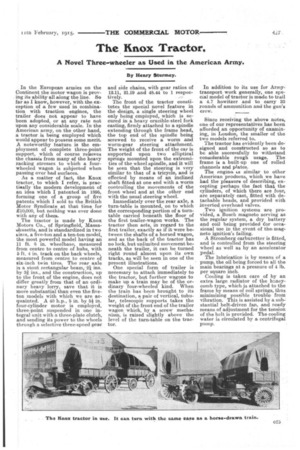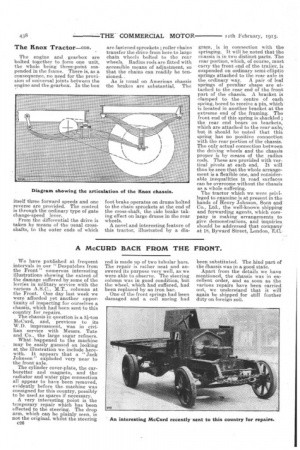The Knox Tractor.
Page 11

Page 12

If you've noticed an error in this article please click here to report it so we can fix it.
A Novel Three-wheeler as Used in the American Army.
By Henry Sturniey.
In the European armies on the Continent the motor wagon is proving its ability all along the line. So far as I know, however, with the exception of a. few used in combination with traction engines, the trailer does not appear to have been adopted, or at any rate not upon any considerable scale. In the American army, on the other hand, a tractor is being employed which would appear to possess some merit. A noteworthy feature is the employment of complete three-point support, which of course relieves the chassis from many of the heavy racking stresses to which a fourwheeled wagon is subjected when passing over bad surfaces.
As a matter of fact, the Knox tractor, to which I refer, is practioally the modern development of an idea which I patented in 1895, forming one of a group of five patents which I sold to the British Motor Syndicate at that time for £10,000, but nothing was ever done with any of them, The tractor is made by Knox Motors Co., of Springfield, Massaohusetts, and is standardized in two aizes, a five-ton and a ten-ton model, the most powerful model having an 11 ft. 8 in. wheelbase, measured from centre to centre of hubs, with 5 ft, 4 in. track on the back wheels, measured from centre to centre of six-inch twin tires. The rear axle is a stout rectangular beam,. 2i ins. by 3i ins., and the construction, up to the front of the engine, does not differ greatly from that of an ordinary heavy lorry, save that it is more substantial than even the fiveton models with which we are acquainted. A 40 h.p., 5 in. by 54 in. four-cylinder motor is employed, three-point suspended in one integral unit with a three-plate clutch, and sending its power to the wheels through a selective three-speed gear and side chains, with gear ratios of 12.11, 21.19 and 48.44 to 1 respectively. The front of the tractor constitutes the special novel feature in the design, a single steering wheel only being employed, which is secured in a heavy crucible-steel fork casting, firmly attached to a spindle extending through the frame head, the top end of the spindle being screwed to receive a worm and worm-gear steering attachment. The weight of the front of the car is supported upon two elliptical springs mounted upon the extremities of the wheel spindle, and it will be seen that the steering is very similar to that of a tricycle, and is effected by means of an inclined. shaft fitted at one end with a worm controlling the movements of the front wheel and at the other end with the usual steering wheel.
Immediately over the rear axle, a turn-table is mounted, on to which the corresponding portion of a turntable carried .beneath the floor of the first trailer-wagon works. The tractor then acts, in regard to the first trailer, exactly as if it were between the shafts of a horsed wagon, and as the back of the tractor has no lock, but unlimited movement beneath the trailer, it can be turned right round almost upon its own tracks, as will be seen in one of the present illustrations.
One special form of trailer is necessary to attach immediately to the tractor, but further wagons to make up a train may be of the ordinary four-wheeled kind. When the train has been brought to its destination, a pair of vertical, tubular, telescopic supports takes the weight of the front end of the trailer wagon i which, by a screw mechanism, s raised slightly above the level of the turn-table on the tractor. In addition to its use for Armytransport work generally, one special model of tractor is made to trail a 4.7 howitzer and to carry 33 rounds of ammunition and the gun's crew.
Since receiving the above notes, one of our representatives has been afforded an opportunity of examining, in London, the smaller of the two models referred to.
The tractor has evidently been designed and constructed so as to be able successfully to withstand considerable rough usage. The frame is a built-up one of rolled channels and plates.
The angina 1,8 similar to other American products, which we have had the pleasure of describing, excepting perhaps the fact that the cylinders, of which there are four, are separately cast., fitted with detachable heads, and provided with inverted overhead valves.
Two ignition systems are provided, a Bosch magneto serving as the regular system, a dry battery and coil being provided or occasional use in the .event of the magneto ignition's failing.
A Stromberg carburetter is fitted, and is controlled from the steering wheel as well as by an accelerator pedal.
The lubrication is by means of a pump, the oil being forced to all the main bearings at a pressure of 4 lb. per square inch.
Cooling is taken care of by an extra large radiator of the honeycomb type, which is attached to the frame by means of coil springs, thus minimizing possible trouble from vibration. This is assisted by a substantial belt-driven fan, and ready means of adjustment for the tension of the belt is provided. The cooling water is circulated by a centrifugal pump. The engine and gearbox are bolted together to form one unit, the whole being three-point suspended in the frame. There is, as a consequence, no need for the provision of universal joints between the engine and the gearbox. In the box itself three forward speeds and one reverse are provided. The control is through the ordinary type of gate change-speed lever.
From the differential the drive is taken by means of the usual crosss-hafts, to the outer ends of which are fastened sprockets ; roller chains transfer the drive from here to large chain wheels bolted to the rear wheels. Radius rods are fitted with accessible means of adjustment, so that the chains can readily be tensioned..
As is usual on American chassis the brakes are substantial. The foot brake operates on drums bolted to the chain sprockets at the end of the cross-shaft, the side brake taking effect on large drums in the rear wheels.
A novel and interesting feature of this tractor, illustrated by a dia gram, is in connection with the springing. It will be noted that the chassis is in two distinct parts. The rear portion, which, of course, must carry the front end of the trailer, is suspended on ordinary semi-elliptic springs attached to the rear axle in the ordinary way. A pair of leaf springs of peculiar shape are attached to the rear end of the front part of the chassis. A bracket is clamped to the centre of each spring, bored to receive a pin, which is located in another bracket at the extreme end of the framing. The front end of this spring is shackled ; the rear end bears on brackets, which are attached to the reat axle, but it should be noted that this spring has no positive connection with the rear portion of the chassis. The only actual connection between the driving wheels and the chassis proper is by means of the radius rods. These are provided with vertical pivots at each end. It will thus be seen that the whole arrangement is a flexible one, and considerable inequalities in road surfaces can be overcome without the chassis as a whole suffering.
The tractor which we were privileged to examine is at present in the hands of Henry Johnson, Sons and Co., Ltd., the well-known shipping an forwarding agents, which company is making arrangements to give demonstrations, and inquiries. should be addressed that company at 18, Byward Street, London, E.G.






















